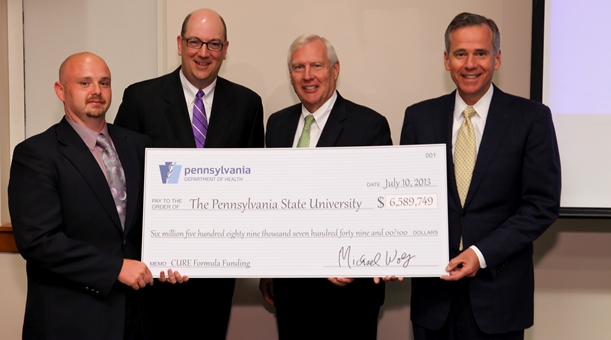Penn State's 2013-14 CURE Program allocation to help support research mission

Penn State has received its annual infusion of tobacco settlement funding, which will help support Penn State Milton S. Hershey Medical Center's research mission. This year, Penn State received nearly $6.6 million. Over the past 12 years, Penn State has received more than $93 million in formula funds – helping to not only explore possible treatments for diseases but also to fuel Pennsylvania’s economy.
At the July meeting of the Medical Center's Board of Directors, Pennsylvania Department of Health Secretary Michael Wolf delivered a check for the Commonwealth Universal Research Enhancement (CURE) Program's formula funds.
“Since 2001, tobacco funds have provided seed funding that has helped faculty members at Pennsylvania's research institutions, including Penn State, win an estimated $2.4 billion in additional funding from the National Institutes of Health, the National Science Foundation and other federal agencies,” said Penn State President Rodney Erickson. “We're proud to partner with the Commonwealth of Pennsylvania on this initiative to advance science, knowledge and the quality of life of Pennsylvania citizens.”
Established in 2001 as a result of the Tobacco Master Settlement Agreement, Pennsylvania's CURE Program distributes settlement funds annually to the state's medical research institutions. Through its distribution of funds, the CURE Program has stimulated economic growth through expansion of the state economy, creation of jobs and more.
Since the start of the program, these funds have created or sustained more than 7,700 high-paying jobs in the academic medical sector, according to a recent economic impact analysis by Tripp Umbach. Some 593 of these jobs resulted from the money received by Penn State Hershey alone, and the state economy has seen a $208.4 million net expansion, as well as $360.2 million in additional federal research funding.
In addition to the check presentation, Wednesday's event featured a video highlighting research by Penn State Hershey faculty members Drs. Walter Koltun and Zachary Simmons. Koltun's and Simmons' work is supported by CURE funds previously awarded to Penn State.
Koltun's CURE program grant will support his work examining the genetic components of diverticulitis. He seeks to explore the correlation between the severity of the disease and its recurrence in families.
Simmons' CURE fund grant will support his study of Amyotrophic Lateral Sclerosis (ALS), otherwise known as Lou Gehrig's disease, which has few treatment options. Simmons will explore the role of genetics in ALS and the potential for targeting treatment regimens to an individual.
Koltun and Simmons are collaborating with scientists at Penn State Hershey Institute for Personalized Medicine. One of the institute's primary goals is to tailor treatments to the individual by considering the genetic influence on the individual's response to medication. The institute gives scientists, such as Koltun and Simmons, the necessary tools to develop research studies exploring these varying genetic factors. Seed money for the institute's specialized space and equipment came from previous years' CURE Program allocations.
“We are grateful to the Commonwealth of Pennsylvania for its continued support of medical research through the CURE program,” said Dr. Harold L. Paz, CEO of the Medical Center and Penn State Hershey Health System, Penn State's senior vice president for health affairs, and dean of Penn State College of Medicine. “These funds make a huge difference not just to our researchers, but above all to the patients and families who look to academic health centers like ours for new discoveries and new hope.”
If you're having trouble accessing this content, or would like it in another format, please email Penn State Health Marketing & Communications.
